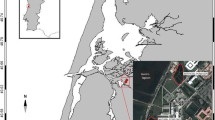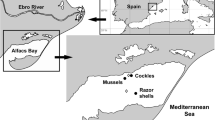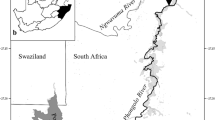Abstract
Background, aim and scope
For reliable environmental risk assessment of pollutants, knowledge on the effects at different levels of biological organisation is needed. During the early days of biomarker research in environmental studies approximately two decades ago, biochemical biomarkers were considered as the most promising tool for such purposes. Among these, three enzymes have often been studied: catalase (CAT), glutathione S-transferase (GST) and cholinesterase (ChE). However, despite their intensive research, their measurements in invertebrates have not been commonly applied in environmental risk assessment (ERA) or for regulatory purposes.
Main features
In the present review, we summarise our past experiences in biochemical biomarker research in two crustacean species: water flea Daphnia magna and terrestrial isopod Porcellio scaber. This is to orientate their use and to provide recommendations for the use of novel biomarkers in environmental studies, such as proteomic or genomic responses.
Results and discussion
We assessed the intrinsic properties of biochemical biomarkers CAT, GST and ChE in the D. magna and the isopod P. scaber. It was found that they are not in agreement with the expectations that were previously given for their use in environmental studies. To advance their use in environmental risk assessment, we suggest that based on their properties, their role should be more specifically defined. ERA includes several distinct steps, among them hazard identification, effect assessment and finally risk characterisation, each of which requires a different type of toxicity data. We recommend that the use of biochemical markers is most appropriate for hazard identification because this is a procedure whose purpose is to characterise the potential hazard of the substance in question and is more flexible in terms of using different tools. Furthermore, our results imply that biochemical markers are not always more sensitive than whole-organism responses, as was anticipated. Their sensitivity depends on the mode of action, duration of exposure and test species. Therefore, we suggest that combining both a battery of biomarkers from different levels of biological organisation and an array of biomarkers within a single level could identify hazard adequately.
Conclusions
The lesson learnt from biochemical biomarkers in environmental studies utilizing crustacean model species is that, for successful application of each group of biomarkers, their intrinsic properties are needed to be known before an (eco)toxicity study is designed. We suggest that a substantial body of experience obtained with biochemical biomarkers should be exploited to new emerging biomarkers in environmental studies in order to facilitate their application.
Recommendations and perspectives
The future of biomarkers lies in a combination of traditional biochemical and new-generation biomarkers. The latter are not only a potential replacement for existing biomarkers but will also provide new knowledge which might encourage renewed research and development of traditional biomarkers. For research purposes, complete ecotoxicity information should include contributions from molecular fingerprint of an organism, as well as whole organism, population and ecosystem responses. Still, the type of biomarkers used for routine purposes will depend on their reproducibility, their ease of use, robustness, affordability of the methodology and the type of chemicals, organisms and ecosystem of interest.


Similar content being viewed by others
References
Abele D, Burlando B, Viarengo A, Pörtner HO (1998) Exposure to elevated temperatures and hydrogen peroxide elicits oxidative stress and antioxidant response in the Antarctic intertidal limpet Nacella concinna. Comp Biochem Physiol 120 B:425–435
Adams SM (2002) Biological indicators of aquatic ecosystem stress. American Fisheries Society, Bethesda, Maryland, USA
Almar MM, Diaz-Mayans J, Romero FJ (1987) Glutathione content and GSH S-transferase activity in midgut gland of Procambarus clarkii. Sex differences, the effect of fasting, and their implications in cadmium toxicity. Comp Biochem Physiol 87C:433–435
Barata C, Baird DJ, Miňarro A, Soares AMVM (2000) Do genotype responses always converge from lethal to nonlethal toxicant exposure levels? Hypothesis tested using clones of Daphnia magna Straus. Environ Toxicol Chem 19:2314–2322
Barata C, Varo I, Navarro JC, Arun S, Porte C (2005) Antioxidant enzyme activities and lipid peroxidation in the freshwater cladoceran Daphnia magna exposed to redox cycling compounds. Comp Biochem Physiol 140 C:175–186
Barata C, Damasio J, Lopez MA, Kuster M, De Alda ML, Barcelo D, Riva MC, Raldua D (2007) Combined use of biomarkers and in situ bioassays in Daphnia magna to monitor environmental hazards of pesticides in the field. Environ Toxicol Chem 26:370–379
Benninghoff AD (2007) Toxicoproteomics—the next step in the evolution of environmental biomarkers. Toxicol Sci 95:1–4
Bishop WE, Clarke DP, Travis CC (2001) The genomic revolution: what does it mean for risk assessment? Risk Anal 21:983–987
Bochetti R, Regoli F (2006) Seasonal variability of oxidative biomarkers, lysosomal parameters, metallothioneins and peroxisomal enyzmes in the mediterranean mussel Mytilus galloprovincialis from Adriatic sea. Chemosphere 65:913–921
Booth LH, O' Halloran K (2001) A comparison of biomarker responses in the earthworm Aporrectodea caliginosa to the organophosphorous insecticides diazinon and chlorpyrifos. Environ Toxicol Chem 20:2494–2502
Brown RJ, Galloway TS, Lowe D, Browne MA, Dissanayake A, Jones MB, Depledge MH (2004a) Differential sensitivity of three marine invertebrates to copper assessed using multiple biomarkers. Aquat Toxicol 66:267–278
Brown PJ, Long SM, Spurgeon DJ, Svendsen C, Hankard PK (2004b) Toxicological and biochemical responses of the earthworm Lumbricus rubellus to pyrene, a non-carcinogenic polycycil aromatic hydrocarbon. Chemosphere 57:1675–1681
Cajaraville MP, Bebianno MJ, Blasco J, Porte C, Sarasquete C, Viarengo A (2000) The use of biomarkers to assess the impact of pollution in coastal environments of the Iberian Peninsula: a practical approach. Sci Total Environ 247:295–311
Calzolai L, Ansorge W, Calabrese E, Denslow N, Part P, Lettieri T (2007) Transcriptomics and proteomics. Applications to ecotoxicology. Comp Biochem Physiol part D 2:245–249
Chora S, McDonagh B, Sheehan D, Starita-Geribaldi M, Romeo M, Bebianno MJ (2008) Ubiquitination and carbonylation as markers of oxidative-stress in Ruditapes decussatus. Mar Environ Res 66:95–97
Connon R, Hooper HL, Sibly RM, Lim FL, Heckmann LH, Moore DJ, Watanabe H, Soetaert A, Cook K, Maund SJ, Hutchinson TH, Moggs J, De Coen W, Iguchi T, Callaghan A (2008) Linking molecular and population stress responses in Daphnia magna exposed to cadmium. Environ Sci Technol 42:2181–2188
Correia AD, Costa MH, Luis OJ, Livingstone DR (2003) Age-related changes in antioxidant enyzme activities, fatty acid composition and lipid peroxidation in whole body Gammarus locusta (Crustacea: Amphipoda). J Exp Mar Biol Ecol 289:83–101
Day KE, Scott IM (1990) Use of acetylcholinesterase activity to detect sublethal toxicity in stream invertebrates exposed to low concentrations of organophosphate insecticides. Aquat Toxicol 18:101–114
De Knecht JA, Stroomberg GJ, Tump C, Helms M, Verwij RA, Commandeur J, Van Gestel CAM, Van Straalen NM (2001) Characterization of enzymes involved in biotransformation of polycyclic aromatic hydrocarbons in terrestrial isopods. Environ Toxicol Chem 20:1457–1464
Demásio JB, Barata C, Munne A, Ginebreda A, Guasch H, Sabater S, Caixach J, Porte C (2007) Comparing the response of biochemical indicators (biomarkers) and biological indices to diagnose the ecological impact of an oil spillage in a Meditteranean river (NE Catalunya, Spain). Chemosphere 66:1206–1216
Depledge MH, Fossi MC (1994) The role of biomarkers in environmental assessment (2). Invertebrates. Ecotoxicology 3:161–172
Depledge MH, Aagaard A, Györkös P (1995) Assessment of trace metal toxicity using molecular, physiological and behavioural biomarkers. Mar Pollut Bull 31:19–27
Diamantino TC, Guilhermino L, Almeida E, Soares AMVM (2000) Toxicity of sodium molybdate and sodium dichromate to Daphnia magna Straus evaluated in acute, chronic and acetylcholinesterase inhibition tests. Ecotoxicol Environ Saf 45:253–259
Diamantino TC, Almeida E, Soares AMVM, Guilhermino L (2003) Characterization of cholinesterase from Daphnia magna Straus and their inhibition by zinc. Bull Environ Contam Toxicol 71:219–225
Drobne D, Blažič M, Van Gestel CAMV, Lešer V, Zidar P, Jemec A, Trebše P (2008) Toxicity of imidacloprid to the terrestrial isopod Porcellio scaber (Isopoda, Crustacea). Chemosphere 71:1326–1334
Elumalai M, Antunes C, Guilhermino L (2002) Effects of single metals and their mixtures on selected enzymes of Carcinus maenas. Water Air Soil Poll 141:273–280
Engenheiro EL, Hankard PK, Sousa JP, Lemos MF, Weeks JM, Soares AMVM (2005) Influence of dimethoate on acetylcholinesterase activity and locomotor function in terrestrial isopods. Environ Toxicol Chem 24:603–609
Forbes VE, Palmqvist A, Bach L (2006) The use and misuse of biomarkers in ecotoxicology. Environ Toxicol Chem 25:272–280
Guilhermino L, Lopes MC, Carvalho AP, Soares AMVM (1996) Acetylcholinesterase activity in juveniles of Daphnia magna Straus. Bull Environ Contam Toxicol 57:979–985
Guilhermino L, Lacerda MN, Nogueira AJA, Soares AMVM (2000) In vitro and in vivo inhibition of Daphnia magna acetylcholinesterase by surfactant agents: possible implications for contamination biomonitoring. Sci Tot Environ 247:137–141
Halliwell B, Gutteridge JMC (2007) Free radicals in biology and medicine. Oxford University Press, New York, USA
Handy RD, Galloway TS, Depledge MH (2003) A proposal for the use of biomarkers for the assessment of chronic pollution and in regulatory toxicology. Ecotoxicology 12:331–343
Hartenstein R (1982) Soil macroinvertebrates, aldehyde oxidase, catalase, cellulase and peroxidase. Soil Biol Biochem 14:387–391
Heckmann LH, Sibly RM, Connon R, Hooper HL, Hutchinson TH, Maund SJ, Hill CJ, Bouetard A, Callaghan A (2008) Systems biology meets stress ecology: linking molecular and organismal stress responses in Daphnia magna. Genome Biol 9:R40.1–R40.14
Jemec A, Drobne D, Tišler T, Trebše P, Roš M, Sepčić K (2007a) The applicability of acetylcholinesterase and glutathione S-transferase in Daphnia magna toxicity test. Comp Biochem Physiol 144 C:303–309
Jemec A, Tišler T, Drobne D, Sepčić K, Fournier D, Trebše P (2007b) Comparative toxicity of imidacloprid, of its commercial liquid formulation and of diazinon to a non-target arthropod, the microcrustacean Daphnia magna. Chemosphere 68:1408–1418
Jemec A, Tišler T, Drobne D, Sepčić K, Jamnik P, Roš M (2008a) Biochemical biomarkers in chronically metal-stressed daphnids. Comp Biochem Physiol 147 C:61–68
Jemec A, Drobne D, Remškar M, Sepčić K, Tišler T (2008b) A dose-independent decrease of activity of two antioxidant enzymes in terrestrial isopods dietary exposed to nanosized titanium dioxide (TiO2). Environ Toxicol Chem 27:1904–1919
Kammenga JE, Dallinger R, Donker MH, Köhler HR, Simonsen V, Triebskorn R, Weeks JM (2000) Biomarkers in terrestrial invertebrates for ecotoxicological soil risk assessment. Rev Environ Contam Toxicol 164:93–147
Keizer J, D'Agostino G, Nagel R, Volpe T, Gnemi P, Vittozzi L (1995) Enzymological differences of AChE and diazinon hepatic metabolism: correlation of in vitro data with the selective toxicity of diazinon to fish species. Sci Total Environ 171:213–220
Khessiba A, Roméo M, Aïssa P (2005) Effects of some environmental parameters on catalase activity measured in the mussel (Mytilus galloprovincialis) exposed to lindane. Environ Pollut 133:275–281
Knowles CO, McKee MJ (1987) Protein and nucleic acid content in Daphnia magna during chronic exposure to cadmium. Ecotoxicol Environ Saf 13:290–300
Koce JD, Razinger J, Dermastia M, Drinovec L, Drobne D, Zrimec A (2007) Antioxidative responses of duckweed (Lemna minor L.) to short-term copper exposure. Environ Sci Pollut Res 14:194–201
Lagadic L (1999) Biomarkers in Invertebrates. In: Peakall DB, Colin HW, Migula P (eds) Biomarkers: a pragmatic basis for remediation of severe pollution in Eastern Europe. NATO Science Series. Kluwer Academic, Dordrecht, Netherlands
Livingstone DR (1998) The fate of organic xenobiotic in aquatic ecosystems: quantitative and qualitative differences in biotransformation by invertebrates and fish. Comp Biochem Physiol 120 A:43–49
Livingstone DR, Lemaire P, Matthews A, Peters LD, Porte C, Fitzpatrick PJ, Förlin L, Nasci C, Fossato V, Wootton N, Goldfarb P (1995) Assessment of the impact of organic pollutants on goby (Zosterisessor ophicephalus) and mussel (Mytilus galloprovincialis) from Venice Lagoon Italy. Mar Environ Res 39:235–240
Ludke JL, Hill EF, Dieter MP (1974) Cholinesterase (ChE) response and related mortality among birds fed ChE inhibitors. Arch Environ Con Tox 3:1–21
Markert B (2007) Definitions and principles for bioindication and biomonitoring of trace metals in the environment. J Trace Elem Med Bio 21:77–82
McCarthy JF, Shugart LR (1990) Biomarkers of environmental contamination. Lewis, Florida, USA
McLoughlin N, Daqiang Y, Lorraine M, Wood RM, Hongxia Y (2000) Evaluation of sensitivity and specificity of two crustacean biochemical biomarkers. Environ Toxicol Chem 19:2085–2092
Mi J, Apraiz I, Cristobal S (2007) Peroxisomal proteomic approach for protein profiling in blue mussels (Mytilus edulis) exposed to crude oil. Biomarkers 12:47–60
Minutoli R, Fossi MC, Granata A, Casini S, Guglielmo L (2007) Use of biomarkers in zooplankton for assessment of the 'health status' of marine and brackish environments: a short overview. Chem Ecol 23:471–477
Monserrat JM, Martínez PE, Geracitano LA, Amado LL, Martins CM, Pinho GL, Chaves IS, Ferreira-Cravo M, Ventura-Lima J, Bianchini A (2007) Pollution biomarkers in estuarine animals:critical review and new perspectives. Comp Biochem Physiol 146 C:221–234
Moore MM (2002) Biocomplexity: the post-genome challenge in ecotoxicology. Aquat Toxicol 59:1–15
Mora P, Fournier D, Narbonne JF (1999) Cholinesterases from the marine mussels Mytilus galloprovincialis Lmk. and Mytilus edulis L. and from freshwater bivalve Corbicula fluminea Müller. Comp Biochem Physiol 122 C:353–361
Mourente G, Díaz-Salvago E (1999) Characterization of antioxidant systems, oxidation status and lipids in brain of wild-caught size-class distributed Aristeus antennatus (Risso, 1816) Crustacea, Decapoda. Comp Biochem Physiol 124 B:405–416
Neumann NF, Galvez F (2002) DNA microarrays and toxicogenomics: applications for ecotoxicology? Biotechnol Adv 20:391–419
Nunes B, Carvalho F, Guilhermino L (2004) Age related chronic effects of clofibrate and clofibric acid on the enzymes acetylcholinesterase, lactate dehydrogenase and catalase of the mosquitofish, Gambusia holbrooki. Chemosphere 57:1581–1589
Olsen T, Ellerbeck L, Fisher T, Callaghan A, Crane M (2001) Variability in acetylcholinesterase and glutathione S-transferase activities in Chironomus Riparius Meigen deployed in situ at uncontaminated field sites. Environ Toxicol Chem 20:1725–1732
Paone JF, Waalkes TP, Baker RR, Shaper JH (1980) Serum UDP-galactosyl transferase as a potential biomarker for breast-carcinoma. J Surg Oncol 15:59–66
Peakall DB (1994) The role of biomarkers in environmental assessment (1). Introduction. Ecotoxicology 3:157–160
Peakall DB, Walker CH (1994) The role of biomarkers in environmental assessment (2).Vertebrates. Ecotoxicology 3:173–179
Poynton HC, Varshavsky JR, Chang B, Cavigiolio G, Chan S, Holman PS, Loguinov AV, Bauer DJ, Komachi K, Theil EC, Perkins EJ, Hughes O, Vulpe CD (2007) Daphnia magna ecotoxicogenomics provides mechanistic insights into metal toxicity. Environ Sci Technol 41:1044–1050
Poynton HC, Wintz H, Vulpe CD (2008) Progress in ecotoxicogenomics for environmental monitoring, mode of action, and toxicant identification. Adv Exp Biol 2:21–73
Printes LB, Callaghan A (2003) Interclonal variability in Daphnia acetylcholinesterase activity: the implications for its applicability as a biomarker. Environ Toxicol Chem 22:2042–2047
Printes LB, Callaghan A (2004) A comparative study on the relationship between acetylcholinesterase activity and acute toxicity in Daphnia magna exposed to anticholinesterase insecticides. Environ Toxicol Chem 23:1241–1247
Radenac G, Bocquene G, Fichet D, Miramand P (1998) Contamination of a dredged-material disposal site (La Rochelle Bay, France). The use of the acetylcholinesterase activity of Mytilus edulis (L.) as a biomarker of pesticides: the need for a critical approach. Biomarkers 3:305–315
Regoli F, Hummel H, Amiard-Triquet C, Larroux C, Sukhotin A (1998) Trace metals and variations of antioxidant enzymes in arctic bivalve populations. Arch Environ Contam Toxicol 35:594–560
Regoli F, Niro M, Chiantore M, Winston GW (2002) Seasonal variations of susceptibility to oxidative stress in Adamussium colbeck, a key bioindicator species for the antartic marine environment. Sci Total Environ 289:205–211
Ribeiro S, Guilhermino L, Sousa JP, Soares AMVM (1999) Novel bioassay based on acetylcholinesterase and lactate dehydrogenase activities to evaluate the toxicity of chemicals to soil isopods. Ecotox Environ Saf 44:287–293
Scholz S, Fischer S, Gündel U, Küster E, Luckenbach T, Voelker D (2008) The zebrafish embryo model in environmental risk assessment—applications beyond acute toxicity testing. Environ Sci Pollut Res 15:394–404
Shaw JR, Pfrender ME, Eads BD, Klaper R, Callaghan A, Sibly RM, Colson I, Jansen B, Gilbert D, Colbourne JK (2008) Daphnia as an emerging model for toxicological genomics. Adv Exp Biol 2(165–219):327–328
Snell TW, Brogdon SE, Morgan MB (2003) Gene expression profiling in ecotoxicology. Ecotoxicology 12:475–483
Stanek K, Drobne D, Trebše P (2006) Linkage of biomarkers along levels of biological complexity in juvenile and adult diazinon fed terrestrial isopod (Porcellio scaber, Isopoda, Crustacea). Chemosphere 64:1745–1752
Stenersen J, Kobro S, Bjerke M, Arend U (1987) Glutathione transferases in aquatic and terrestrial animals from nine phyla. Comp Biochem Physiol 86C:73–82
Sturm A, Hansen PD (1999) Altered cholinesterase and monooxygenase levels in Daphnia magna and Chironomus riparius exposed to environmental pollutants. Ecotoxicol Environ Saf 42:9–15
TGD Document (2003) Technical Guidance Document on Risk Assessment, part II. European Commission. http://europa.eu.int
Van der Oost R, Beyer J, Vermeulen NPE (2003) Fish bioaccumulation and biomarkers in environmental risk assessment: a review. Environ Toxicol Phar 13:57–14
Van Gestel CAM, Van Brummelen TC (1996) Incorporation of the biomarker concept in ecotoxicology calls for a redefinition of terms. Ecotoxicology 5:217–225
Vega-López A, Galar-Martínez M, Jiménez-Orozco FA, García-Latorre E, Domínguez- López ML (2007) Gender related differences in the oxidative stress response to PCB exposure in an endangered goodeid fish (Girardinichthys viviparus). Comp Biochem Physiol 146 A:672–678
Walker CH (1992) Biochemical responses as indicators of toxic effects of chemicals in ecosystems. Toxicol Lett 64/65:527–533
Walker CH (1999) The use of biomarkers in vertebrates. In: Peakall DB, Colin HW, Migula P (eds) Biomarkers: a pragmatic basis for remediation of severe pollution in Eastern Europe. NATO Science Series. Kluwer Academic Publishers, Dordrecht, Netherlands
Watanabe H, Takahashi E, Nakamura Y, Oda S, Tatarazako N, Iguchi T (2007) Development of a Daphnia magna DNA microarray for evaluating the toxicity of environmental chemicals. Environ Toxicol Chem 26:669–676
Acknowledgement
This work was financially supported by Slovenian Research Agency and the Slovenian Science Foundation (WFS National Scholarship). We thank Dr. Bill Milne for editing and commenting the manuscript.
Author information
Authors and Affiliations
Corresponding author
Rights and permissions
About this article
Cite this article
Jemec, A., Drobne, D., Tišler, T. et al. Biochemical biomarkers in environmental studies—lessons learnt from enzymes catalase, glutathione S-transferase and cholinesterase in two crustacean species. Environ Sci Pollut Res 17, 571–581 (2010). https://doi.org/10.1007/s11356-009-0112-x
Received:
Accepted:
Published:
Issue Date:
DOI: https://doi.org/10.1007/s11356-009-0112-x




